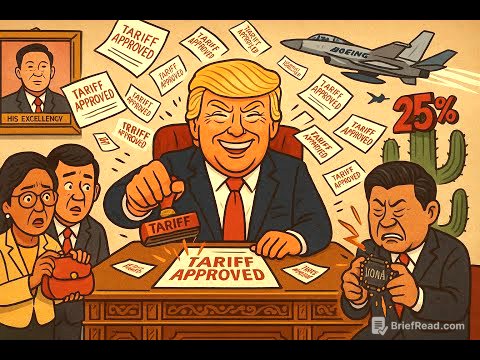TLDR;
This video explores the power of illusion and its impact on warfare, psychology, marketing, and individual perception. It discusses historical examples of military deception, psychological disorders rooted in illusion, and the manipulation of consumer behavior through marketing. The video emphasizes the importance of awareness and critical thinking to distinguish between reality and illusion, and encourages viewers to focus on self-awareness rather than seeking an absolute truth.
- The Ghost Army during World War II used illusion to deceive the enemy.
- Illusion can be a weapon or a virus, depending on how it's used.
- Psychological disorders like hypochondria and obsessive-compulsive disorder are rooted in illusion.
- Marketing and propaganda use illusion to shape consumer behavior.
- Awareness and critical thinking are essential to distinguish between reality and illusion.
The Ghost Army: Warfare by Deception [0:01]
During World War II, the United States formed the Ghost Army, a unit of artists, engineers, and designers, to create illusions and deceive the enemy. Their first mission, Operation Fortitude, involved creating a fake army in the Kiel area to mislead the Germans about the location of the Allied invasion. The Ghost Army's efforts successfully diverted German forces, contributing to the success of the Normandy landings. The Ghost Squad participated in more than 22 missions in which they deluded the enemy.
The Mind as a Battlefield: Historical Examples of Illusion in Warfare [0:40]
Throughout history, controlling the enemy's mind has been seen as crucial to controlling their land. The Tartars used psychological tricks, such as feigned retreats, to create illusions of victory and then easily defeat their enemies. In the Battle of Ain Jalut, the Mamluk Sultan Saif al-Din Qutuz turned the tables on the Tatars by using their own tactics of illusion against them, leading to a decisive victory. Napoleon Bonaparte's overconfidence and belief in his own invincibility led to his disastrous invasion of Russia, demonstrating how illusion can also lead to downfall.
Psychological Delusions: Trapped in Unreal Realities [1:42]
Many people are defeated before the war even begins because they believe the image of fear and thought illusion was real. Plato's allegory of the cave illustrates how people can live their entire lives in a cognitive prison, mistaking shadows for reality. Psychological shocks and traumas can create illusions that imprison individuals, leading them to believe that their lives are over.
The Power of Illusion: Hypochondria and the Mind-Body Connection [1:59]
Hypochondria is a dangerous form of delusion where individuals imagine diseases and dangers that don't exist, exaggerating simple events into health crises. A study in the British Medical Journal described a construction worker who experienced paralysis and extreme pain after stepping on a nail, only to discover the nail hadn't even pierced his skin. Isaac Newton suffered from morbid delusions, believing his friends were plotting against him, highlighting how even brilliant minds can be deceived by their own thoughts.
The Mind's Control: Pain, Fear, and Obsessive-Compulsive Disorder [3:19]
The mind can amplify feelings of pain and fear, leading to conditions like obsessive-compulsive disorder (OCD). OCD is characterized by recurring, insistent thoughts and obsessions that drive individuals to perform repetitive actions to prevent perceived disasters. Illusion can be used to control people's minds, as demonstrated by an anesthesiologist who used saline solution as a placebo during World War II, convincing soldiers that they were receiving morphine and alleviating their pain.
The Placebo Effect: Harnessing the Power of Belief [4:06]
The placebo effect shows that believing in a treatment can trigger the mind to release painkillers and promote healing. A carpenter unknowingly had a 10 cm nail stuck in his head for six days without feeling any pain, illustrating the mind's ability to control the perception of pain. Arabic sayings like "Do not pretend to be sick, lest you get sick yourself" reflect the power of the mind to influence physical health.
Marketing and Illusion: Shaping Consumer Behavior [4:37]
Sam Walton built the Walmart empire by using psychological techniques to direct customers and reshape their decisions, creating the illusion of freedom of choice. Edward Bernays, a founder of public relations, argued that people are often unaware of the real reasons behind their behavior and are influenced by unseen forces. Tobacco companies used the slogan "Torches of Freedom" to link cigarettes with women's independence, exploiting illusion to increase profits.
Diamonds Are Forever: Creating the Illusion of Value [5:19]
De Beers transformed diamonds from undesirable stones into symbols of eternal love with the slogan "Diamonds are forever," creating an illusion of value and driving sales. This campaign demonstrates how marketing can create collective illusions that shape social traditions and consumer behavior.
Awareness and Perspective: Navigating the World of Illusion [5:38]
The mind can create both dreams and prisons, and awareness is key to distinguishing between them. There is no absolute truth or complete illusion, as everyone's perspective is shaped by their experiences and filters. Instead of searching for the truth, individuals should focus on self-awareness and controlling their own filters of perception to see the whole picture.









